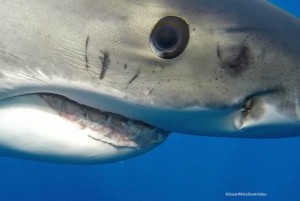Part of the great white shark’s mystique is its unnerving gaze, a sort of blank stare, as though from a creature whose soul has departed its body.
Some might recall the chilling description delivered more than 40 years ago by the gruff shark hunter Quint, in the thriller Jaws:
“Y’know the thing about a shark, he’s got… lifeless eyes, black eyes, like a doll’s eyes. When he comes at ya, doesn’t seem to be livin…”
But the great white shark’s gaze, much like creature itself, is not so mysterious after all. Its eyes, although they appear black and lifeless from a distance, are blue and complex. The shark does not stare blankly about, but squarely at objects, the same as other creatures.
This is the topic of a Sharkminutes segment posted to Facebook over the weekend by White Shark Video, with experts Skyler Thomas and Andy Delios discussing their footage from various shark-diving destinations.
The segment opens with a close pass and a rare look into a great white shark’s eyeball rolling in its socket as it looks at the camera while swimming past the cage.
If the lighting is right, the true color of a great white shark’s eye is revealed.
“Contrary to what Quint told us in Jaws, it is not a black, lifeless doll eye,” Thomas says. “In fact, there’s a lot going on in that eye. It has an iris, a pupil, cornea… and some beautiful blue coloring. And if you catch it in a good enough light, and the shark is swimming by slowly, you can see that he’s looking at you, while you look back at him.”
Catching a shark’s eye in the right light is critical, or it will appear black and lifeless.
The White Shark Video segment also addresses the appearance of a white shark’s eyes as the shark feeds.
While many species of sharks utilize a protective membrane that covers the eye as it bites into prey items, white sharks simply roll their eyes back into their sockets, “which can make the shark look kind of scary, too,” Thomas explains, “because you then have this white, where an eyeball used to be, but this is for a specific purpose.”
White sharks prey largely on elephant seals, gigantic pinnipeds that’ll fight back if given a chance. As a result, white sharks often bear gaping wounds and scars on their faces and heads.
Footage for the Sharkminutes segment was captured off Mexico, Australia, and South Africa. Tiger shark footage was captured at the Bahamas.






